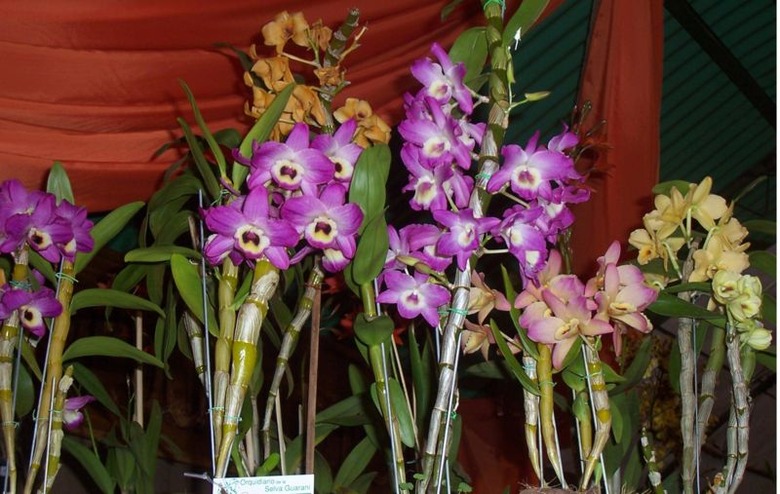How To Grow A Dendrobium Orchid
Things Needed
- Water
- Orchid food
- Orchid growing medium
- Spray mist bottle
- Saucer or tray
- Small stones or pebbles
Dendrobium orchids are one of the many thousands of epiphytic orchid varietals in existence. They do not grow in ground soil but instead pull nutrients and moisture from the air and from the surface they are attached to. Dendrobiums are widely sold in florist shops and grocery stores. They are identifiable by their long arching spikes of multiple flowers and a crenelated thick stem that resembles bamboo. Dendrobiums are easily grown as an indoor plant and will bloom once a year when given consistent care.
Step 1
Select a location for your orchid where daytime temperatures hover between 75 and 85 degrees Fahrenheit and night temperatures remain above 60 degrees Fahrenheit. Place your dendrobium where it will receive bright morning sun but have shade from mid-morning to mid-afternoon when the sun it as its peak strength. Late afternoon sun is fine and bright indirect light is always welcome.
- Dendrobium orchids are one of the many thousands of epiphytic orchid varietals in existence.
- Dendrobiums are easily grown as an indoor plant and will bloom once a year when given consistent care.
Step 2
Water your dendrobium when the planting medium is just dried out and the pot feels light in weight. Teach yourself to judge when the plant needs water by feeling the pot's weight when fully soaked with water. Knowing how a freshly watered pot feels allows you know when your plant requires water. Mist your orchid once a day or every other day if you are in a dry climate or are running the air conditioning or heat as these sap the desirable humidity from the air. Alternatively, assemble a humidity tray in a saucer that your orchid can pot can sit atop. Place small stones in a saucer or tray at least two inches deep and at least two inches larger than the diameter of your orchid pot. Fill the saucer to the lip with water. This creates a humid micro-climate around your orchid in which it will thrive. Replenish the water as needed to keep the tray full. Never allow the orchid roots to sit in water as this will force the plant to drop its bloom and die back.
- Water your dendrobium when the planting medium is just dried out and the pot feels light in weight.
- Mist your orchid once a day or every other day if you are in a dry climate or are running the air conditioning or heat as these sap the desirable humidity from the air.
Step 3
Feed your dendrobium once a month with a water-soluble high-nitrogen orchid food. Apply according to the manufacturer's recommendations. Always water your orchid before pouring the diluted fertilizer through the planting medium to prevent burning to roots and to speed the uptake of the applied nutrients.
Step 4
Repot your orchid into fresh orchid planting medium every other year in the spring after bloom has faded or before it begins. Use a commercial bagged orchid mix that contains fir bark and charcoal shards. Gently remove any old medium stuck to or among the orchid roots and choose a pot at least one size up from the previous but not so large as to swamp the roots because they like to feel the limits of a perimeter.
Step 5
Allow the flower spike to die back in place to feed energy back into the plant. Cut it off only when it is brown and dried. Never cut the leaves off when they die. Simply allow them to yellow in place and when ready to be removed they will lift off the stem with the gentlest of tugs.
- Feed your dendrobium once a month with a water-soluble high-nitrogen orchid food.
- Gently remove any old medium stuck to or among the orchid roots and choose a pot at least one size up from the previous but not so large as to swamp the roots because they like to feel the limits of a perimeter.
